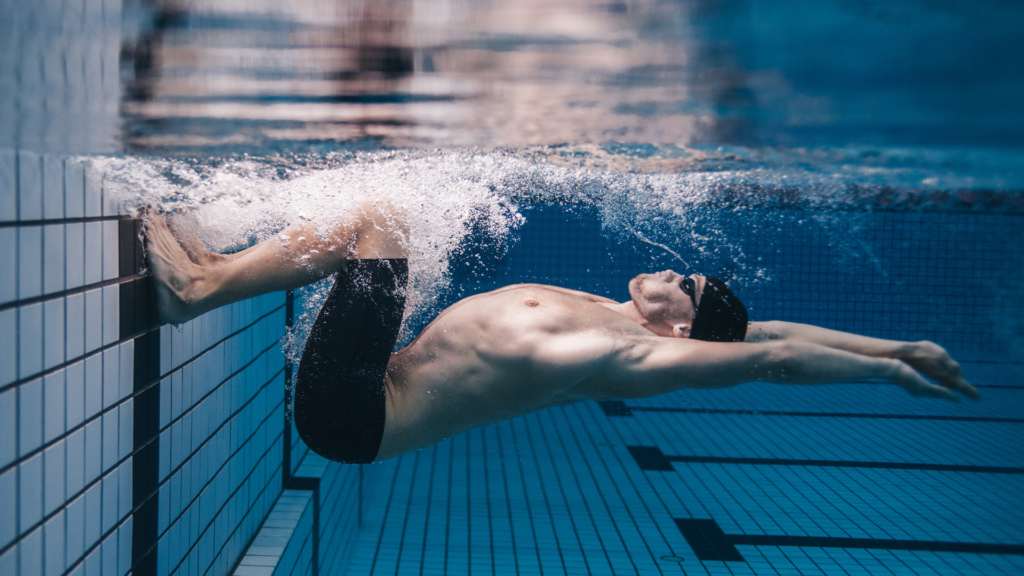Hello, fellow swimmers! Today, we’re diving into the world of tech suits. If you’re a seasoned swimmer, you know that a tech suit is more than just a swimsuit. It’s a technical racing suit designed to help you swim faster and more efficiently. But, the key to unlocking its full potential lies in finding your perfect fit. But how should a tech suit fit? Let’s get into it!
Understanding Tech Suits
First things first, let’s clarify what a tech suit is. A technical suit is a high-performance swimsuit worn by competitive swimmers. Unlike your everyday practice suit, a tech suit is specifically designed for racing. It’s all about reducing drag and enhancing your performance in the water.
For a more in-depth look at tech suits, check out our article on the science behind technical suits.

The Purpose of a Tech Suit in Swimming
In the world of competitive swimming, a tech suit serves a crucial role. Unlike regular swimwear, a tech suit is a high-performance piece of equipment designed to enhance a swimmer’s speed and efficiency in the water.
The primary purpose of a tech suit is to reduce drag. Drag is the resistance a swimmer encounters when moving through the water. By minimizing this resistance, tech suits allow swimmers to move more swiftly and smoothly, effectively helping them swim faster.
The Materials Used in Tech Suits and Their Benefits
Tech suits are made from a blend of fabrics like polyester and elastane. These materials provide the compression needed to keep your muscles tight and well-supported. They also reduce water absorption, making you lighter and faster in the water.
But the real game-changer is the surface of the tech suit. It’s designed to mimic the smooth and streamlined skin of a shark. This helps to reduce drag in the water, allowing you to swim faster.
Different Types of Tech Suits Available
There are various types of tech suits available, each designed to cater to different needs and preferences. Here are a few:
- Jammer: This is a popular choice among male swimmers. It extends from the waist to just above the knee, providing a full range of motion and excellent compression.
- Kneeskin: Preferred by female swimmers, this suit covers the body from the shoulders to the knees. It offers a snug fit and reduces drag, helping you swim faster.
- Full Bodyskin: This suit covers the entire body, from the neck to the ankles. While it offers the most coverage, it’s not commonly used due to restrictions by swimming federations.
Choosing your tech suit depends on your comfort, the level of compression you want, and the rules of the swimming federation you’re competing under.
The Importance of the Right Fit
Finding the perfect fit for your tech suit is not just about comfort; it’s a crucial factor that can significantly impact your performance in the water.
How the Fit of a Tech Suit Affects Performance
A well-fitting tech suit can enhance your swimming performance in several ways.
- It provides the necessary compression to support your muscles, reducing fatigue and improving endurance.
- It reduces drag, allowing you to cut through the water more efficiently.
- A well-fitting tech suit can boost your confidence, and as any seasoned swimmer knows, a positive mindset can make a world of difference in a race.
The Balance Between Comfort and Compression
While a tech suit should be tight, it’s essential to find a balance between comfort and compression. A suit that’s too tight can restrict your movement and cause discomfort, which can negatively impact your performance. On the other hand, a suit that’s too loose won’t provide the necessary compression and can increase drag. The key is to find a tech suit that feels like a second skin, providing the right amount of compression without compromising comfort.
Potential Issues with a Poorly Fitting Tech Suit
A poorly fitting tech suit can lead to several issues. It can restrict your movement, making it harder to perform your strokes correctly. It can cause discomfort or even pain, distracting you during your race. Moreover, a suit that doesn’t fit properly can increase drag, slowing you down in the water. Therefore, it’s crucial to take the time to find a tech suit that fits you perfectly.
How Should a Tech Suit Fit

Finding the perfect fit for your tech suit involves paying attention to several key areas. Let’s break it down:
The Ideal Fit Around the Waist and Navel
Your tech suit should sit comfortably around your waist and navel. It should be snug but not so tight that it digs into your skin or restricts your breathing. The back of the suit should fully cover your backside without riding up or causing discomfort.
The Right Fit for the Crotch Area
The crotch area of the suit should fit snugly against your body. This helps to minimize drag and provide support. However, it shouldn’t be so tight that it’s uncomfortable or restricts movement. Remember, a good suit should enhance your performance, not hinder it.
The Correct Tightness of the Suit’s Straps
The straps of the tech suit should be snug but not dig into your shoulders. They should be tight enough to keep the suit in place but not so tight that they restrict your movement or cause discomfort. If the straps leave deep marks on your shoulders, the suit may be too tight.
The Importance of Non-Restrictive Movement
Above all, a tech suit should allow for a full range of motion. You should be able to perform all your swim strokes without feeling restricted. If the suit is too tight in any area, it can hinder your movement and negatively impact your performance.
Tips and Tricks for Fitting a Tech Suit
Finding the perfect fit for your tech suit can be a bit of a challenge, but don’t worry; I’ve got you covered. Here are some tips and tricks to help you find your perfect fit.
How to Measure Yourself for a Tech Suit
Before you even start looking at tech suits, you need to know your measurements. Here’s a quick guide on how to measure yourself:
- Chest: Measure around the fullest part of your chest, keeping the tape measure level.
- Waist: Measure around your natural waistline, which is the narrowest part of your waist.
- Hips: Measure around the fullest part of your hips.
- Torso Loop: Start the tape at your shoulder, and bring it down through your legs and up your back to meet the end of the tape at the shoulder.
Remember, tech suits are designed to be tight, but not uncomfortably so. When in doubt, refer to the suit’s size chart.
Understanding Tech Suit Size Charts
Each brand has its own size chart, and it’s crucial to refer to these when choosing your tech suit. These charts take into account the measurements we just discussed and give you a corresponding suit size.
But remember, these charts are just a guide. The suit may feel incredibly tight when you’re putting it on, but that’s normal. You’ve likely found the right size as long as it doesn’t restrict your movement or cause discomfort.
Tips for Putting on a Tech Suit
Putting on a tech suit is a bit of an art. Here are some tips to make the process easier:
- Be Dry: Make sure you’re completely dry. Any moisture can make the suit stick and harder to put on.
- Take Your Time: Don’t rush. Putting on a tech suit properly can take up to 20 minutes.
- Use Plastic Bags: Putting plastic bags on your feet can help your legs slide through the suit more easily.
- Avoid Fingernails: Avoid using your fingernails when pulling the suit up. This can damage the delicate fabric.
How to Check if Your Tech Suit Fits Correctly
Once you’ve got the suit on, it’s time to check the fit. Here’s what to look for:
- Straps: They should be snug but not dig into your shoulders.
- Waist: The suit should sit comfortably around your waist. It should be snug but not digging into your skin.
- Legs: The leg openings should be tight against your skin but not pinching.
- Range of Motion: You should be able to move freely. Try some swim strokes to make sure the suit doesn’t restrict your movement.
A well-fitting tech suit can make a world of difference in your performance.
🔍 Feeling ready to find the perfect tech suit? Dive into my comprehensive guide on the top tech suits for swimmers! 🏊♂️
Maintaining Your Tech Suit
Now that you’ve found your perfect tech suit, it’s essential to take care of it to maintain its fit and performance. Here are some tips on how to do just that.
How to Care for Your Tech Suit to Maintain Its Fit and Longevity
Tech suits are a significant investment, so you want to make sure they last. For more detailed information about proper maintenance and the expected lifespan of your new suit, check out our article on lifespan and care here. Here are a few basics:
- Rinse After Use: Always rinse your tech suit in cold water after use to remove chlorine and other chemicals.
- Hand Wash: Never machine wash your tech suit. Instead, hand wash it gently with a mild soap.
- Air Dry: Don’t wring out your tech suit. Instead, gently squeeze out the excess water and let it air dry away from direct sunlight.
- Avoid Heat: Never use a dryer or heater to dry your tech suit. Heat can damage the fabric and affect the suit’s performance.
- Store Properly: Store your tech suit flat in a cool, dry place. Avoid folding it to prevent creases and damage to the fabric.
When to Consider Replacing Your Tech Suit
Even with the best care, tech suits don’t last forever. Over time, the fabric can stretch and lose its compression. When this happens, it’s time to consider getting a new tech suit.
A good rule of thumb is to replace your tech suit every six to twelve months, depending on how often you use it. But ultimately, you should replace your tech suit when it no longer provides the compression and performance you need.
FAQs
Conclusion
We’ve covered a lot of ground in this article, from understanding what a tech suit is to finding your perfect fit and taking care of your suit. Remember, a well-fitting tech suit can significantly enhance your performance in the water. But it’s also essential to be comfortable and to take care of your suit to ensure it lasts.
Finding the right tech suit is a journey, and I hope this guide has helped you on your way. Remember, the goal is to find a tech suit that fits you perfectly. It should feel like a second skin, enabling you to perform at your best.
So, take your time, find the right suit, and get ready to swim like never before. Until next time, happy swimming!






